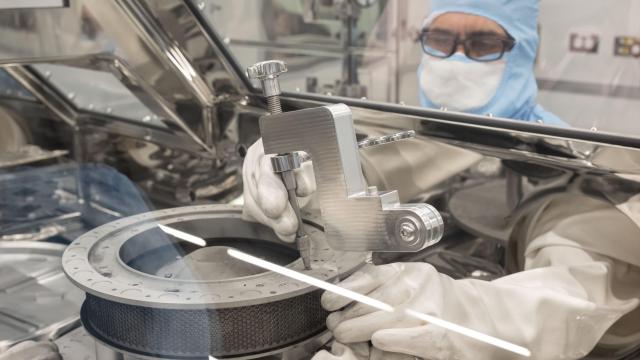After months of fidgeting with a canister that contained rocky samples from an ancient asteroid, NASA engineers have finally removed two stubborn fasteners that appeared to be preventing the space agency from collecting the full amount of Bennu’s debris.
The OSIRIS-REx curation team managed to remove the TAGSAM (Touch-and-Go Sample Acquisition Mechanism) head, where the bulk of the asteroid sample is stored, NASA announced in a blog post on Thursday. The team was forced to develop new tools to help remove the two fasteners that held the sampler head shut since it landed on Earth in September 2023.
“Our engineers and scientists have worked tirelessly behind the scenes for months to not only process the more than 70 grams of material we were able to access previously, but also design, develop, and test new tools that allowed us to move past this hurdle,” Eileen Stansbery, division chief for ARES (Astromaterials Research and Exploration Science) at NASA, said in a statement. “The innovation and dedication of this team has been remarkable. We are all excited to see the remaining treasure OSIRIS-REx holds.”
There are still a few disassembly steps left before the remainder of the bulk sample is fully revealed and image specialists can take ultra-high-resolution pictures of it while it’s still inside the TAGSAM head. Afterwards, the sample will be removed and weighed, and NASA will determine the full amount of rocky debris OSIRIS-REx snagged from Bennu.
The OSIRIS-REx mission launched in September 2016 and reached asteroid Bennu in December 2018. The spacecraft snagged pieces of a small, near-Earth asteroid in October 2020 and began making its way back to Earth in May 2021. The spacecraft dropped off the sample in the Utah desert in September 2023, but NASA has been struggling to crack open a round sampler head at the end of an articulated arm that the spacecraft used to grab the sample.
Two of the 35 fasteners on the TAGSAM head could not be removed with the current tools approved for use in the OSIRIS-REx glovebox, preventing them from extracting the sample inside.
“In addition to the design challenge of being limited to curation-approved materials to protect the scientific value of the asteroid sample, these new tools also needed to function within the tightly-confined space of the glovebox, limiting their height, weight, and potential arc movement,” Nicole Lunning, OSIRIS-REx curator at NASA, said in a statement.
